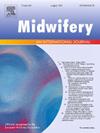Development and psychometric testing of the Perception of Childbirth Environment Scale in Taiwan
IF 2.6
3区 医学
Q1 NURSING
引用次数: 0
Abstract
Background
Previous research has shown that women's perceptions of their childbirth environment are critical in ensuring that they feel supported and in facilitating physiological childbirth.
Aim
To develop and validate the Perception of Childbirth Environment Scale (PCES) for expectant mothers.
Methods
The PCES was developed based on findings from a scoping review and a qualitative study on childbirth environments conducted by the authors. The scale underwent expert review to ensure relevance, clarity, and content validity, followed by face validity testing with five women. A total of 193 participants, recruited from two medical institutions, completed the PCES within 48 h after childbirth. Reliability was assessed using Cronbach's α for internal consistency. Construct validity was evaluated through exploratory and confirmatory factor analyses.
Results
The PCES comprised 10 items divided into two dimensions: comfort and control. “Comfort” factors included privacy, homeliness, familiarity, relaxation facilitation, and a sense of continuity in the room, while “Control” factors were reflected in elements like a birth companion, empowerment, and safety. The model demonstrated a good fit following exploratory and confirmatory factor analyses, as well as adjustments based on modification indices.
Conclusions
The PCES displayed strong reliability and validity, making it a suitable tool for assessing women's perceptions of their labor and childbirth environment.
台湾分娩环境感知量表的开发与心理测试
背景以往的研究表明,妇女对分娩环境的感知对于确保她们感受到支持和促进生理分娩至关重要。方法PCES是根据作者对分娩环境进行的范围综述和定性研究的结果编制的。该量表经过了专家评审,以确保其相关性、清晰度和内容有效性,随后又在五名妇女中进行了面效测试。从两家医疗机构招募的 193 名参与者在产后 48 小时内完成了 PCES。信度采用 Cronbach's α 进行内部一致性评估。结果PCES包括10个项目,分为两个维度:舒适和控制。"舒适 "因素包括私密性、家的温馨感、熟悉感、放松便利性和房间的连续感,而 "控制 "因素则反映在陪产人员、授权和安全等要素上。经过探索性和确认性因素分析以及基于修正指数的调整,该模型显示出良好的拟合度。结论PCES显示出很强的可靠性和有效性,使其成为评估产妇对其分娩环境看法的合适工具。
本文章由计算机程序翻译,如有差异,请以英文原文为准。
求助全文
约1分钟内获得全文
求助全文
来源期刊

Midwifery
医学-护理
CiteScore
4.50
自引率
7.40%
发文量
221
审稿时长
13.4 weeks
期刊介绍:
Midwifery publishes the latest peer reviewed international research to inform the safety, quality, outcomes and experiences of pregnancy, birth and maternity care for childbearing women, their babies and families. The journal’s publications support midwives and maternity care providers to explore and develop their knowledge, skills and attitudes informed by best available evidence.
Midwifery provides an international, interdisciplinary forum for the publication, dissemination and discussion of advances in evidence, controversies and current research, and promotes continuing education through publication of systematic and other scholarly reviews and updates. Midwifery articles cover the cultural, clinical, psycho-social, sociological, epidemiological, education, managerial, workforce, organizational and technological areas of practice in preconception, maternal and infant care.
The journal welcomes the highest quality scholarly research that employs rigorous methodology. Midwifery is a leading international journal in midwifery and maternal health with a current impact factor of 1.861 (© Thomson Reuters Journal Citation Reports 2016) and employs a double-blind peer review process.
 求助内容:
求助内容: 应助结果提醒方式:
应助结果提醒方式:


